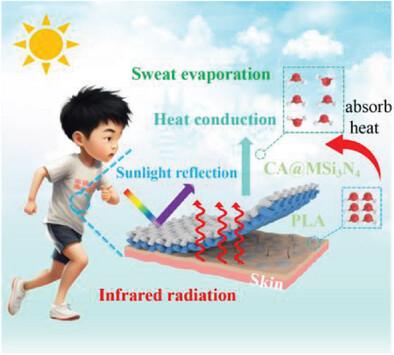Our official English website, www.x-mol.net, welcomes your feedback! (Note: you will need to create a separate account there.)
A High‐Performance Passive Radiative Cooling Metafabric with Janus Wettability and Thermal Conduction
Small ( IF 13.0 ) Pub Date : 2024-06-28 , DOI: 10.1002/smll.202403751 Peibo Du 1 , Xingshun Zhao 1 , Xiongwei Zhan 1 , Xiaoyan Li 1 , Keru Hou 1 , Yating Ji 1 , Zhuizhui Fan 1 , Javed Muhammad 2 , Fengyan Ge 1 , Zaisheng Cai 1
Small ( IF 13.0 ) Pub Date : 2024-06-28 , DOI: 10.1002/smll.202403751 Peibo Du 1 , Xingshun Zhao 1 , Xiongwei Zhan 1 , Xiaoyan Li 1 , Keru Hou 1 , Yating Ji 1 , Zhuizhui Fan 1 , Javed Muhammad 2 , Fengyan Ge 1 , Zaisheng Cai 1
Affiliation

|
With the development of industry and global warming, passive radiative cooling textiles have recently drawn great interest owing to saving energy consumption and preventing heat‐related illnesses. Nevertheless, existing cooling textiles often lack efficient sweat management capacity and wearable comfort under many practical conditions. Herein, a hierarchical cooling metafabric that integrates passive radiation, thermal conduction, sweat evaporation, and excellent wearable comfort is reported through an electrospinning strategy. The metafabric presents excellent solar reflectivity (99.7%, 0.3–2.5 µm) and selective infrared radiation (92.4%, 8–13 µm), given that the unique optical nature of materials and wettability gradient/micro‐nano hierarchical structure design. The strong moisture‐wicking effect (water vapor transmission (WVT) of 2985 g m−2 d−1 and directional water transport index (R) of 1029.8%) and high heat‐conduction capacity can synergistically enhance the radiative cooling efficiency of the metafabric. The outdoor experiment reveals that the metafabric can obtain cooling temperatures of 13.8 °C and 19.3 °C in the dry and sweating state, respectively. Meanwhile, the metafabric saves ≈19.3% of annual energy consumption compared with the buildings with HAVC systems in Shanghai. The metafabric also demonstrates desirable breathability, mechanical strength, and washability. The cost‐effective and high‐performance metafabric may offer a novel avenue for developing next‐generation personal cooling textiles.
中文翻译:

具有 Janus 润湿性和导热性的高性能被动辐射冷却超织物
随着工业的发展和全球变暖,被动辐射冷却纺织品由于节省能源消耗和预防与热有关的疾病而引起了人们的极大兴趣。然而,现有的冷却纺织品在许多实际条件下往往缺乏有效的排汗能力和穿着舒适度。在此,通过静电纺丝策略报道了一种集被动辐射、热传导、汗液蒸发和出色的可穿戴舒适度于一体的分层冷却超织物。鉴于材料独特的光学性质和润湿性梯度/微纳米分层结构设计,超织物呈现出优异的太阳反射率(99.7%,0.3–2.5 µm)和选择性红外辐射(92.4%,8–13 µm)。强的吸湿排汗效应(水蒸气透过率(WVT)为2985 g m−2 d−1,定向水输送指数(R)为1029.8%)和高导热能力可以协同增强超织物的辐射冷却效率。室外实验表明,超织物在干燥和出汗状态下分别可以获得13.8℃和19.3℃的冷却温度。同时,与上海采用HAVC系统的建筑相比,超织物每年可节省约19.3%的能耗。该超织物还表现出理想的透气性、机械强度和可洗性。这种经济高效且高性能的超织物可能为开发下一代个人冷却纺织品提供新途径。
更新日期:2024-06-28
中文翻译:

具有 Janus 润湿性和导热性的高性能被动辐射冷却超织物
随着工业的发展和全球变暖,被动辐射冷却纺织品由于节省能源消耗和预防与热有关的疾病而引起了人们的极大兴趣。然而,现有的冷却纺织品在许多实际条件下往往缺乏有效的排汗能力和穿着舒适度。在此,通过静电纺丝策略报道了一种集被动辐射、热传导、汗液蒸发和出色的可穿戴舒适度于一体的分层冷却超织物。鉴于材料独特的光学性质和润湿性梯度/微纳米分层结构设计,超织物呈现出优异的太阳反射率(99.7%,0.3–2.5 µm)和选择性红外辐射(92.4%,8–13 µm)。强的吸湿排汗效应(水蒸气透过率(WVT)为2985 g m−2 d−1,定向水输送指数(R)为1029.8%)和高导热能力可以协同增强超织物的辐射冷却效率。室外实验表明,超织物在干燥和出汗状态下分别可以获得13.8℃和19.3℃的冷却温度。同时,与上海采用HAVC系统的建筑相比,超织物每年可节省约19.3%的能耗。该超织物还表现出理想的透气性、机械强度和可洗性。这种经济高效且高性能的超织物可能为开发下一代个人冷却纺织品提供新途径。






































 京公网安备 11010802027423号
京公网安备 11010802027423号